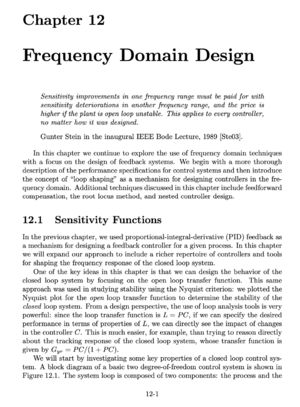Difference between revisions of "Frequency Domain Design"
Jump to navigation
Jump to search
(Created page with "{{Chapter |Chapter number=12 |Previous chapter=PID Control |Next chapter=Robust Performance }}") |
|||
| (6 intermediate revisions by the same user not shown) | |||
| Line 1: | Line 1: | ||
{{Chapter | {{Chapter | ||
|Chapter number=12 | |Chapter number=12 | ||
| + | |Short name=loopsyn | ||
|Previous chapter=PID Control | |Previous chapter=PID Control | ||
|Next chapter=Robust Performance | |Next chapter=Robust Performance | ||
| + | |First edition URL=https://www.cds.caltech.edu/~murray/amwiki/index.php?title=Frequency_Domain_Design#Frequently_Asked_Questions | ||
| + | |Chapter summary=In this chapter we continue to explore the use of frequency domain techniques with a focus on the design of feedback systems. We begin with a more thorough description of the performance specifications for control systems and then introduce the concept of “loop shaping” as a mechanism for designing controllers in the frequency domain. Additional techniques discussed in this chapter include feedforward compensation, the root locus method, and nested controller design. | ||
| + | |Chapter contents=# Sensitivity Functions | ||
| + | # Performance Specifications | ||
| + | #* Response to Reference Signals | ||
| + | #* Response to Load Disturbances and Measurement Noise | ||
| + | #* Measuring Specifications | ||
| + | # Feedback Design via Loop Shaping | ||
| + | #* Design Considerations | ||
| + | #* Lead and Lag Compensation | ||
| + | # Feedforward Design | ||
| + | #* Combining Feedforward and Feedback | ||
| + | #* Difficulties with Feedforward | ||
| + | #* Approximate Inverses | ||
| + | # The Root Locus Method | ||
| + | # Design Example | ||
| + | # Further Reading | ||
| + | :: Exercises | ||
}} | }} | ||
Latest revision as of 21:35, 28 August 2021
| Prev: PID Control | Chapter 12 - Frequency Domain Design | Next: Robust Performance |
In this chapter we continue to explore the use of frequency domain techniques with a focus on the design of feedback systems. We begin with a more thorough description of the performance specifications for control systems and then introduce the concept of “loop shaping” as a mechanism for designing controllers in the frequency domain. Additional techniques discussed in this chapter include feedforward compensation, the root locus method, and nested controller design.
